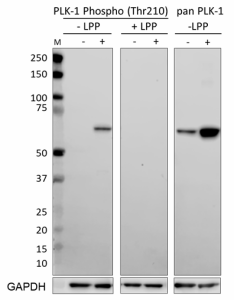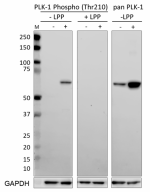- Clone
- 3F8; 2A3;
- Regulatory Status
- RUO
- Other Names
- Polo Like Kinase 1,STPK13, Cell Cycle Regulated Protein Kinase
- Ave. Rating
- Submit a Review
- Product Citations
- publications

-

Whole cell extracts (15 µg protein) from serum starved HeLa untreated (-) or treated (+) with 200 ng/mL nocodazole for 20 hours were resolved on a 4-12% Bis-Tris gel and transferred to a PVDF membrane. Membranes were treated (+ LPP) or untreated (- LPP) with lambda protein phosphatase, overnight at 4°C and probed with 0.5 µg/mL (1:1000 dilution) of purified anti-PLK-1 Phospho (Thr210) antibody (clone 2A3) for 2 hours at room temperature. Proteins were visualized by chemiluminescence detection using HRP goat anti-mouse IgG antibody (Cat. No. 405306) at a 1:3000 dilution. Purified anti-PLK-1 antibody (clone 3F8) was used as a pan PLK-1 loading control at 1.0 µg/mL. Lane M: Molecular weight marker. Direct-Blot™ HRP anti-GAPDH antibody (Cat. No. 607904) was used as a loading control at a 1:25000 dilution (lower). Purified anti-PLK-1 antibody (clone 3F8) was used as a pan PLK-1 loading control at 1.0 µg/mL. Lane M: Molecular weight marker.
| Cat # | Size | Price | Quantity Check Availability | Save | ||
|---|---|---|---|---|---|---|
| 699956 | 1 kit | £129 | ||||
PLK-1 (polo-like kinase 1) is a member of the Polo-like kinase family of serine/threonine protein kinases. While PLK-1 phosphorylates a broad range of targets, it has been shown to be a critical regulator of cell cycle pathways, ranging from mitotic entry to initiation of cytokinesis. Elevated PLK1 expression is described in many cancers and is associated with poor clinical outcomes. Increased PLK-1 activity is associated with resistance to doxorubicin and gemcitabine in certain cancers. Activation of PLK-1 requires phosphorylation of Thr210 within the T-loop of the catalytic domain by Aurora kinases.
Product DetailsKit Contents
- Kit Contents
-
Product Application Clone Size Reactivity Isotype Purified anti-PLK-1 Antibody WB 3F8 25 μg Human, Mouse Mouse IgG1, κ Purified PLK-1 Phospho (Thr210) Antibody WB 2A3 25 μg Human Mouse IgG1, κ
* For detailed information about each specificity, please refer to the datasheets of the individual products.
Product Details
- Verified Reactivity
- Human
- Immunogen
- Please refer to individual product datasheets for immunogen information
- Formulation
- Phosphate-buffered solutions, pH 7.2, containing 0.09% sodium azide
- Preparation
- The antibodies were purified by affinity chromatography.
- Storage & Handling
- The antibody solutions should be stored undiluted between 2°C and 8°C.
- Application
-
WB - Quality tested
- Recommended Usage
-
Each lot of antibodies in this set is quality control tested by Western blotting. For Western blotting, the suggested uses of these reagents are as follows:
Clone 3F8: 0.2 - 1.0 µg/mL
Clone 2A3: 0.5 - 1.0 µg/mL
It is recommended that the reagent be titrated for optimal performance for each application.
For recommended usage information for additional applications, please refer to the datasheet of the individual products.
Antigen Details
- Structure
- PLK1 is a 603 amino acid protein with a predicted molecular weight of ~68 kD.
- Distribution
-
Ubiquitously expressed; highly expressed in placenta and colon/Centrosomes and kinetochore
- Function
- Mitotic signaling
- Antigen References
-
1. Hamanaka R, et al. 1994. Cell Growth Differ. 5:249.
2. Lake RJ, et al. 1993. Mol. Cell. Biol. 13:7793.
3. Holtrich U, et al. 1994. P. Natl. Acad. Sci. USA 91:1736. - Gene ID
- 5347 View all products for this Gene ID
- UniProt
- View information about PLK-1 on UniProt.org
Related Pages & Pathways
Pages
Related FAQs
Other Formats
View All PLK-1 Reagents Request Custom Conjugation| Description | Clone | Applications |
|---|---|---|
| PhosphoPair PLK-1 (Thr210) Antibody Set | 3F8; 2A3 | WB |
Compare Data Across All Formats
This data display is provided for general comparisons between formats.
Your actual data may vary due to variations in samples, target cells, instruments and their settings, staining conditions, and other factors.
If you need assistance with selecting the best format contact our expert technical support team.
-
PhosphoPair PLK-1 (Thr210) Antibody Set

Whole cell extracts (15 µg protein) from serum starved HeLa ...
 Login / Register
Login / Register 












Follow Us